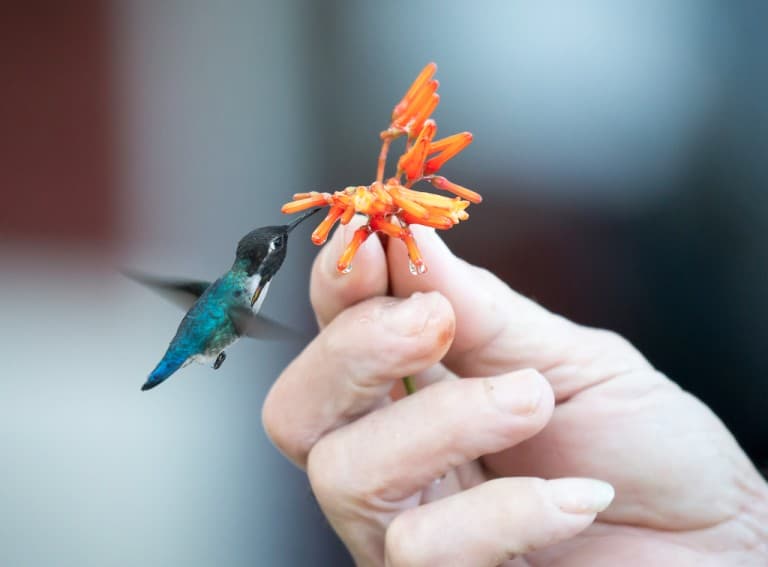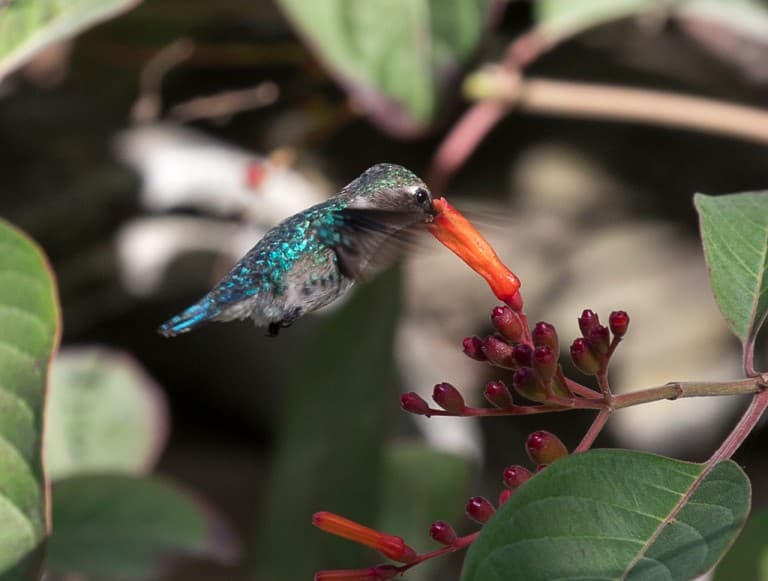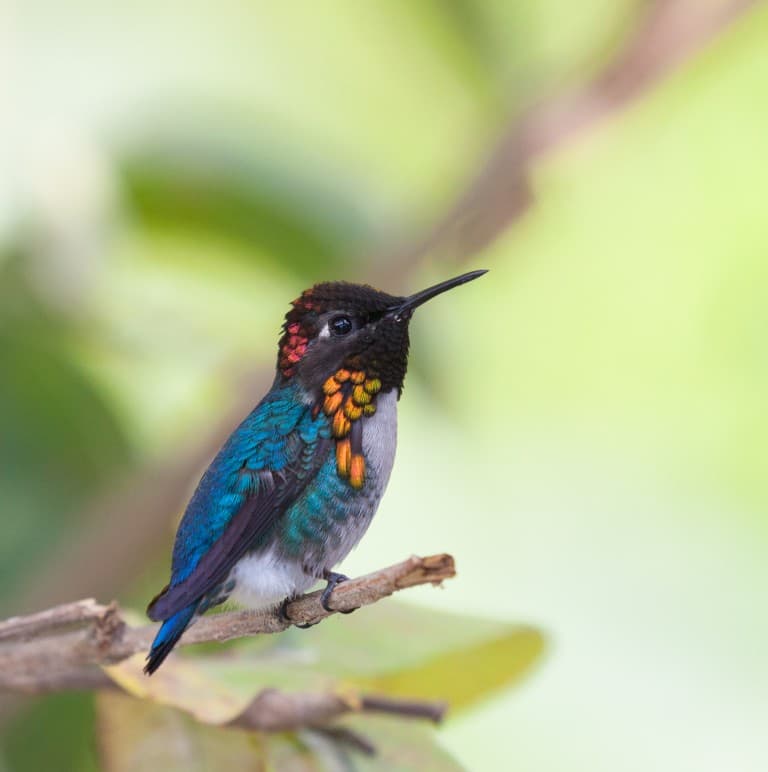Bee Hummingbird Profile
About the size of a bumblebee, the bee hummingbird is the smallest bird on earth. With a wingspan averaging 3cm and a body length less than 6cm, these tiny birds are often mistaken for flying insects.
They are more rotund than most hummingbird species and also have a relatively short beak. Males are coloured in greenish-blue iridescent plumage while females are more drab, but slightly larger than their male counterpart.
Bee hummingbirds are native to Cuba, where they are found in a variety of habitats including gardens and parks.

Bee Hummingbird Facts Overview
| Habitat: | Subtropical forests, gardens and coasts, preferably where the plant Solandra grandiflora grows |
| Location: | Native to Cuba |
| Lifespan: | 7 years in the wild |
| Size: | Body length 5.5 – 6 cm, wingspan 3cm |
| Weight: | 2g – 2.6 grams |
| Color: | A stout hummingbird with a short beak. Males and females have grey underparts while males have iridescent blue to green backs and wings and females are more dull |
| Diet: | Mainly nectar, but also feeds on insects and spiders |
| Predators: | Larger birds and possibly frogs, reptiles, rats and even fish |
| Top Speed: | Up to 48 kph (30 mph) |
| No. of Species: |
1 |
| Conservation Status: |
Near Threatened |
Bee hummingbirds spend a huge amount of time flying and are often in flight for the entire day searching for food. They feed predominantly on nectar and show a definite preference for the nectar from the Solandra grandiflora flower, which is endemic to Cuba.
Other than nectar, these minuscule birds will also catch and eat spiders and small insects in flight, especially when rearing chicks.
For such a tiny bird, they are capable of flying at remarkably fast speeds and like other hummingbirds, they are able to fly backwards and their muscles are well developed to keep them in the air for long periods of time.
Bee hummingbirds can be rather fussy about the nectar they eat, preferring only the flowers that contain nectar containing higher concentrations of sugars. Therefore they tend to be found in greater numbers where flowers are abundant, and can be particularly territorial of their feeding areas.
Bee hummingbirds lead a mostly solitary life and will aggressively chase other bee hummingbirds away from their territory, as well as attacking bumblebees – and other nectar-feeding insects that attempt to feed in their territory.
The bee hummingbird population is declining and they are considered near threatened in terms of their conservation status. As they rely so heavily on flowering plants for their survival, habitat loss is the biggest threat these tiny birds face.
Designated protected areas as well as flowering gardens and more eco-friendly farming practices provide the plants needed for bee hummingbirds to survive. Some species of plant have evolved to be specifically pollinated by these birds and thus the survival of the bee hummingbird ensures the survival of many different flowering species of plant.
Interesting Bee Hummingbird Facts
1. They are the smallest bird in the world
Measuring less than 6cm long and weighing just a couple of grams, bee hummingbirds are smaller than many flying insects and the smallest living bird. 1 2
2. Bee hummingbirds can spend all day in flight
These tiny birds may spend up to 20 hours a day in flight, searching for nectar. 3
3. They lay eggs about the size of a coffee bean
Most often two tiny eggs, each about the size of a coffee bean, are laid and when the chicks hatch, they are entirely dependent on their mother.
Once the chicks have developed their flight muscles, they usually leave the nest and are independent at just over 1 month old.
Due to their fast-paced lifestyle, bee hummingbirds usually only live to approximately 7 years in the wild, however this is longer than many other similar species.
4. Males take no part in upbringing
Female bee hummingbirds are solely responsible for the care and upbringing of their chicks. They build elegant, cup-shaped nests that are well lined with moss and spider silk and usually contain downy feathers to help keep eggs warm.
5. They get their name from the sound their wings make
When bee hummingbirds beat their wings, this occurs so rapidly that a humming sound is produced.

6. People used to wear stuffed hummingbirds on their hats
During the Victorian era, woman use to put stuffed hummingbirds on their hats as a fashion statement. 4
7. They require a huge amount of food each day
Relative to size, bee hummingbirds may use more than 10 times the amount of energy that marathon runners do.
As they are such active birds, bee hummingbirds require large amounts of food to fuel their bodies and can visit 1,500 flowers each day in search of food.
The flowers from which they feed do not have perching platforms so the bee hummingbird must hover and use its long tongue to access the nectar in the flower.
They also use this method when attempting to pull insects or spiders from flower petals. Like other hummingbirds they have tiny feet that are used solely for perching and resting.
When they have obtained the necessary amount of food, bee hummingbirds find thin, exposed branches to rest on during the night and are able to slow their metabolism down during the cooler periods so as reduce energy loss.
8. Their wings can beat over 80 times a second
While hovering to collect nectar, bee hummingbirds are able to beat their wings more than 80 times per second.
9. They are able to fly backwards
Hummingbirds have special shoulder joints that can rotate and allow them to fly backwards or hover for long periods of time.
10. Bee hummingbirds have special areas on their bodies to avoid overheating
Hovering creates a huge amount of heat and hummingbirds have areas around their eyes and legs that allow the excess heat to escape.
11. Males perform songs and show off to females
During the breeding season, male bee hummingbirds congregate in what are known as leks, where they try to outcompete one another for the chance to mate with a female. Males try to attract females by singing and showing off their iridescent plumage in flight.
Females usually choose the most healthy and attractive males and these males may mate with several females during the breeding season. Where large numbers of males are found, females will visit several leaks in search of a suitable mate. 5
12. Female and males have different colouration
While females are usually a plain turquoise colour on their backs and wings, males have blueish-green iridescent upper-parts and red, iridescent heads and throats.

13. They have one of the fastest breathing rates in the animal kingdom
When in flight, bee hummingbirds can breathe well over 250 times per minute. 6
14. They have to contend with a lot of predators
As they are such small birds, bee hummingbirds are predated upon by several different predators. Their most common predators are hawks and other fast-flying birds of prey.
These raptors usually catch the hummingbirds while they are hovering and feeding or when they are perched on exposed branches.
The chicks are sometimes eaten by a variety of animals such as rats and snakes, although the mother will vigorously attack approaching predators with little regard for her own safety.
Occasionally bee hummingbirds are also eaten by fish when they collect water from river and streams and opportunistic frogs will even attempt to catch these birds when they are resting.

Bee Hummingbird Fact-File Summary
Scientific Classification
| Kingdom: | Animalia |
| Phylum: | Chordata |
| Class: | Aves |
| Order: | Apodiformes |
| Family: | Trochilidae |
| Genus: | Mellisuga |
| Species Name: |
Mellisuga helenae |
Fact Sources & References
- (2021), “Bee Hummingbird: The Smallest Living Birds”, Beauty of Birds.
- (2017), “Get to Know the Bee Hummingbird, the World’s Smallest Bird”, Audubon.
- Bo Dalsgaard (2012), “FLORAL TRAITS OF PLANTS VISITED BY THE BEE HUMMINGBIRD (MELLISUGA HELENAE)”, Research Gate.
- (1999), “hummingbird”, Britannica.
- “Mellisuga helenae bee hummingbird”, Animal Diversity Web.
- “Trochilidae”, Science Direct.
